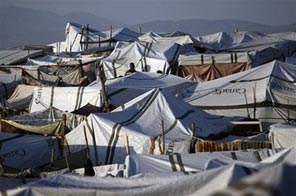Haiti's quake survivors don't wait for gov't plan
PORT-AU-PRINCE: Haiti's government and aid groups have been wrangling for five weeks over a plan for housing earthquake survivors, but the people haven't waited.
Rows of makeshift tents sprouted in open fields around the wrecked capital, and Haitians soon began strengthening the shelters. The camps have grown into shanty towns — with bakeries and even lottery stands — that show no sign of moving soon.
While the camps blossomed, officials debated what to do with the 1.2 million people left homeless by the disaster. Should they be given ready-made tents or plastic tarps? What land should be made available? The government may announce a plan Thursday.
The delay has complicated the task, as seen at a former landing strip-turned-boulevard called Route de Piste, where a cluster of ramshackle villages has taken root.
Row upon row of corrugated tin and wood shacks stand against the wind as dusty men walk between them carrying saws and hammers. Children look for the snow cone man at the crossroads, near where a lottery dealer named Max has set up his booth. In a shack marked "Boulangerie Pep La" — the people's bakery — the smell of dough wafts from the oven, and two flat rolls cost 5 gourdes, about 12 cents.
These shanty towns are redrawing the map of the capital, filling open fields with new versions of the joyful life and harsh crime and abuse that always marked existence in the slums — with an extra helping of disease, hunger and misery brought on by the Jan. 12 disaster, which killed more than 200,000 people.
This means people are planning to stay in some very dangerous places: at the bottom of hillsides they know will collapse in a heavy rain or near riverbeds that are bound to flood. They are crowded into polluted areas where sanitation is limited and disease is already starting to spread.
"The government has said for weeks that they have identified sites, but time is getting short and there has been little progress," said Ian Bray, an Oxfam spokesman.
That's one problem. Another is that people simply do not want to go far from where they always lived and worked. With property hard to come by, aftershocks continuing and 38 percent of Port-au-Prince's buildings destroyed by the magnitude-7 quake, according to U.N. satellite imagery, their options are limited.
"People are displaced, they've lost their homes but they haven't lost their jobs," said Alex Wynter of the International Federation of Red Cross and Red Crescent Societies. "The key issue is land."
French President Nicolas Sarkozy, making the first visit ever by a French head of state to his nation's former colony, pledged 16,000 tarps and 1,000 tents to house 200,000 people while touring the ruins of Port-au-Prince's collapsed national palace Wednesday.
Haiti's own leader, President Rene Preval, has been less decisive.
"We have to find a solution to get people under shelter — a combination of tents, tarps, corrugated tin roofs ... whatever combination it is," Preval told The Associated Press during a half-hour interview this week. He did not elaborate.
For the people now living under a big flagpole, the decision has already been made.
"If they chase after us, we'll leave. Until then we're here," said Lens Beny, a 20-year-old water peddler who built an 8-by-9-foot 8 (2.4 by 2.7-meter) wood-and-tin shack for himself and five relatives. His front door is a lace curtain; the roof is a garbage bag that leaves a solid third of the shanty exposed to the sky.
It is, in a manner of speaking, a temporary shelter — the sort officials are counting on people to build as 250,000 tarps are handed out ahead of the spring rainy season and more permanent solutions are reached.
It's also an unpleasant place to live. One recent rain shower destroyed the flimsy particle boards he bought for $3.70 each, Beny said, as he ripped off a clump of wall.
The new neighborhood is very densely packed; some 27,000 people live there, according to Haitian Red Cross workers. U.N., foreign and local officials are directing aid to the site, while also designating it a "priority for decongestion" — meaning some people must move out.
The overcrowding is the chief reason officials say they don't want to give people the waterproof tents they are demanding — there just isn't enough space for them.






